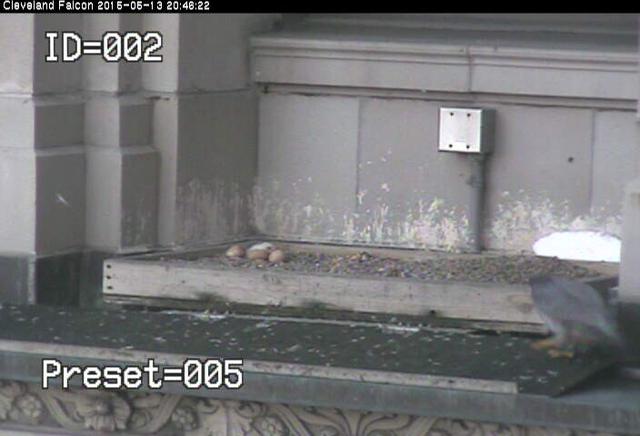FALCON FLASH
Dateline: Cleveland, Ohio
May 13, 2015
Click here to read what happened earlier
Will the remaining 4 eggs hatch? Nest monitor Mrs. Saladin comments, “As excited as I am, though, I'm prepared for the likelihood that they may not all hatch (not to be a party pooper, but trying to be realistic). The typical clutch size is 3-4 eggs for peregrines and even then there's often one egg that doesn't hatch.”
Watch closely at: http://www.falconcam-cmnh.org/news.php
Our thanks to the Cleveland Museum of Natural History for sponsoring the FalconCams and for the still.
Photos and video are courtesy of volunteers Mr. and Mrs. Saladin.
It has been a long wait, and falcon fans have been nervous …….. but Newton and Boomer proudly announce the hatching of their first egg. Welcome to the world, little guy!
The tiny falcon, properly known as an “eyass”, began to break through its shell with a “pip” which is a hole in the egg. Mr. Harvey Webster, Director of Wildlife Resources at the Cleveland Museum of Natural History tells us: “Pipping is the act of creating a breach in the shell and shell membrane so that the chick can establish respiratory function. After the pip there is a quiet phase where the chick draws blood back into its body from the shell membrane. Once complete, the chick will then vigorously score the inside of the shell with its egg tooth while simultaneously pushing against the blunt cap of the egg with its neck. After scoring the shell for two thirds of its circumference the chick pushes against the cap and it flexes back enough for the chick to push its way out. It generally takes 24-36 hours between the onset of the pip and actual hatching”. In the following file photo you can see a little beak enlarging the pip.
Mrs. Saladin answers this question: “In a couple of the pics of Newton she had her left eyelid closed, which is why it looked to the kids like it was damaged. Interestingly, peregrines have a clear protective membrane (known as a nictitating membrane) that "blinks" over the eye when needed from the inside corner out and they have a tan-to-yellowish colored eyelid that closes from the bottom to the top when they are resting or shielding their eyes from the sun. They will occasionally rest with just one eyelid closed as you and your kids saw in those pics”. Here is Boomer resting:
As you can imagine, humans don’t usually get to watch a hatch in person. Mr. and Mrs. Saladin were lucky enough to see a newly hatched chick at another nest that they monitor. In the following video, you can watch the hard work a little chick must do as it emerges from its egg. Mr. and Mrs. S were able to video while the mother falcon was briefly gone, but as soon as she came back they stopped:
Over the last week, Falcon fans have been patiently watching the FalconCam images carefully for signs of a hatch. We suspected it was underway because Newton refused to take a break. Females do not like to leave their eggs during hatching, but a girl has to take a quick break every now and then.
It's fun to record the date that each egg hatches and then record the eyass’s growth and progress. When does it have its first meal and what will that be? When will it take its first step? When will it get its first real feather? When will it fly? You can do this in a falcon journal, a technique that wildlife biologists use as they study the peregrines. To help you record the eyass's progress, you can go to the FalconCam and click on the archives link under each of the 3 current pictures to see all the day's activities.
As we wait for more chicks to hatch, here’s an interesting falcon fact. Some falcon fans were worrying that there might have been something wrong with Newton’s eye in the following picture:
Former volunteer nest monitor at this site, Mr. Scott Wright, tells us: "The chicks will spend a great deal of time sleeping and huddled together for warmth. What to look for..... You want to see each kid with two wings, two legs, two eyes and a beak, you also want to see the "begging response", any time a parent is near...... The parents will cover (mantle) the young for 4-7 days. The young are not able to control body temperature (self-regulate) for about a week, if it stays chilly”.
Lately, Cleveland has had some warmer weather and when that happens, you may notice that the parents sit on the chick and remaining eggs with their backs arched and feathers fluffed as in the following picture:
Click here to read what happened next






